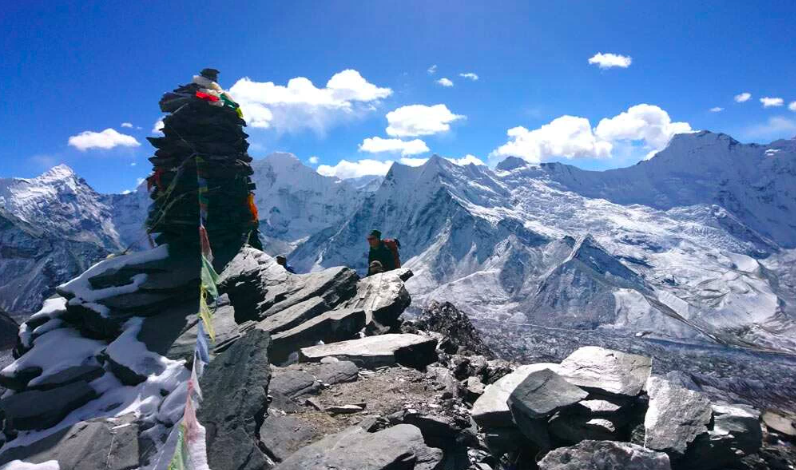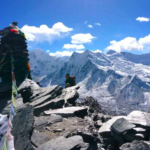The ultimate challenge is to try Everest Three High Pass Trek, an odyssey that will never be forgotten with some of the most awe-inspiring views on the planet. Set in the Himalayas, this trek means they would be crossing three of the most dangerous high passes in the world, Kongma La-Cho La-Renjo La each offering breath-taking panoramas and adventure at every turn. Immediately upon stepping foot on the trail, you will be overcome by wild and dramatic views of the peaks around you. The giants of the Everest massif are standing above, such as Lhotse and Ama Dablam, — their high silhouettes overlaid on a sky that with a flaming orange at sunset.
This journey unfolds a kaleidoscope of landscapes as trekkers marvel at the visually stunning panoramas. Over pristine ridges—with verdant valleys blush with vibrant rhododendron blooms in spring, rushing rivers carving their way through rocky gorges. Every day is a new backdrop, sides of mountains, alpine lakes mirroring the sky and changing terrains higher up with snow views. The isolation of these untouched places further created a sense of oneness with nature, in which the spectacle invites moments for contemplation.
These cultural encounters are interwoven into the adventure, adding depth beyond the physical challenges themselves. The course takes you through ancient Sherpa villages, where the prayer flags are waving in the wind and one can still hear chanting of monasteriesounding in the air. You will then be guided through rich cultural insights and the deep, spiritual connections held by the mountains with the warm-hearted Sherpa people. The measured touch of nature and culture serve to further shape the trek, connecting you to the humanity that thrives in this pristine wilderness.
As you make your way up the mountain trekking, altitude acclimatization is essential for your body to become accustomed to air at high altitudes. The ascent to the passes is grueling and taxing in ways that challenge both the physical and mental fortitude of those brave enough to complete it, but the glory of it cannot be understated. Once you reach the top of Kongma La, trekkers are showered with an unforgettable sight when taking a look at gigantic peaks and glaciers surrounding them as far as the eyes can see. Crossing Cho La, with cold glacial wasteland and slippery ice trails, is an ultimate sense of accomplishment. Then there’s a relative peace around Renjo La, almost little company might visit this territory and some bewitching perspectives warrant a shrouded jewel comment too!
Coming to the end of a trek something inside you changes, it leaves its mark on your soul. Everest Three High Pass Trek Together with the gasp-worthy vistas, the bonds formed with fellow walkers and the profound affinity to protect the environment; it makes for a life-changing journey. The Everest Three High Pass Trek is more than a test of physical resilience; it affords an opportunity to immerse oneself in the profound aesthetic experience of the Himalayas, reflecting on one’s own small place there. For the adventurous at heart, this trail weaves through mountains that form the backdrop to scenes of profound transformation and offers each breathtaking experience along the way as a testament to being human, having seen what we were capable for just a moment.
Everest three High Pass Adventure — An overview
Everest Three High Passes Trek, written by: Info Hub The Everest Three High Pass trek is an incredible journey designed for adventure lovers who wish to explore one of the most beautiful sections in the world due to its natural surroundings. This trek, in the heart of the Himalayas leads us into serene valleys with vibrant colors and testing conditions where nature holds hands with culture. Covering a span of 18-20 days, the trek will take you to three high passes—Kongma La Pass, Cho La Pass, RenjoLa Passexplicitely offering magnificent views of gigantic peaks like that of Mount Everest. On the way, trekkers are greeted with rich Sherpa culture that includes quaint villages, old monasteries to collect tales on and lovely locals who welcome you with open arms. It was not just a journey to such great heights, it was about feeling this beautiful land and its inhabitants closer. The daunting prospect of high-altitude trekking is counterweighted by a succession of calm vistas that carry immense spiritual weight along the way, making this valley one of the most transformative experiences in the Himalayas. Whether you are a well-seasoned trekker or just new to travelling, the Everest Three High Pass Trek boasts amazing scenic sights and exceptional experiences that intrigued every outdoorsman yearning for a remarkable escapade in some of the world top background.
The Allure of the Himalayas
Himalayas, often called Roof of the World with its bewitching mountain range grab a sight of every adventurer and nature enthusiasts. One of the most prominent peaks on this grand scale is Mount Everest, which alongside Kanchenjunga and Lhotse forms one of the highest mountain ranges in the world, running through five countries including Nepal, India and Tibet. The Himalayas are not just tall, but they allure the wanderlust in you with mountains that span across mind-numbing spectrums! Between lush green valleys and cascading waterfalls to rugged terrains and glacial lakes, the surrounding countryside is rich in natural beauty. The light playing with the shadows on the mountains provides an ever-shifting canvas, the scenes during sunrise and sunset mostly have all the peaks casting a golden glow. Also, the Himalayan people very rich tapestry of cultures which especially among the Sherpa communities enhances the experience. With its intriguing traditions, colourful festivals and extreme spirituality, the region is filled with charm that blends nature together with culture in every step of our trek. For the globetrotting spirits, the Himalayas are an invitation to connect with the land and its timeless elements — not in a way that is portrayed in Instagram profiles of fellow travelers; but deeply seeded and embedded within yourself.
Trekking Survival Kit
PROPER TRAIL PREPARATION:While approaching to the Everest Base Camp Trek is mandatory for you since it helps in offering a more secured and exciting adventure. It is important that anyone planning to do this trek be in Good Physical Condition, and have been Doing Cardiovascular Exercises such as running, biling or hiking for at least one Month prior. The demanding climbs are best taken on with legs and core geared up for the long haul which building endurance and strength will prepare you for. Also preparing mentally as high altitude trekking is physically demanding and could get on your moral stakes. Knowing the signs of altitude sickness as well as methods for acclimatization are key. Correct gear is important; the right boots, t-shirts and backpack to keep you comfortable for long periods walking tide cause of careful planning. You should also carry a first-aid kit, hydration system and relevant trekking permits along. It can only make the experience richer, grounded and build respect and relationship with usually hospitable Sherpa villages you come across. Last but not the least keeping an open mind and being ready to face weather changes will make your trek experience even better. So as long as trekkers are adequately prepared, they can get right into the action of this thrusting region and start to explore everything that the Everest Region has to offer.
Choosing Your Route
Since there are several routes to the Everest Three High Pass Trek, it is a must to choose the right way according to one´s stamina and desires. The traditional route usually starts from Lukla and trekkers hit via the colorful market town of Namche Bazaar, gate to Everest. One of the paths leads to several options in how trekkers can connect their way around the three high passes. Trekking in this circuit is through the high pass first to Kongma La, Cho La and finally Renjo La(sea level 5416 m), This is a traditional one, but offers you enough time and flexibility for proper acclimatization. The Renjo La route is likely less crowded, thus maybe more attractive for trekkers looking for a quieter experience. Moreover, a few trekkers would likewise plan to consolidate some additional side trips to notorious spots like Gokyo Lakes or the Everest Base Camp for an all-encompassing experience husk This is a hard and intense route ideal for evaluating your individual hiking capabilities or time limits. In the end, it comes down to picking the right one so that trekkers can be excited about their trek as well as feel delighted about what beauty they beheld in the Everest zone.
Itinerary Breakdown: Day-by-Day
A Good Itinerary is Vital For the Everest Three High Pass Trek to ensure proper acclimatization and best experience for trekking. Most people start their journey with a flight from Kathmandu to Lukla, and then walk to Phakding where they sleep the first night. The following day brings us up to Namche Bazaar, which sits at the top of a hill and serves as a colourful cultural mix with lovely views in all directions that makes for a great acclimatization point. The next few days consist of treks to Dingboche and Lobuche with all leading up to the first high pass, Kongma La. It is a difficult climb but provides trekkers with incredible 360-degree views. The next couple of days will be the trekking of Gorak Shep to Everest Base Camp, a must do on all bucket lists! You will spend next few days crossing Cho La (en route to the more dramatic landscapes you can hope to see) and Renjo La, which provides 360-degree panoramic views and a true feeling of wilderness. The trek finally reaches Lukla before it ends, generally with a lot of memories from the journey/enlightenment. Every day a delicate balance between physical activity and wonder, cultural experience and personal growth. This complex itinerary does not only add portions to the safety of the trek but also considerably adds in the richness of adventure making it remembered for years.
High Altitude Acclimatization Techniques
Since you will be trekking on high altitudes, it is vital for you to acclimatize to these heights which is an important part of the Everest Three High Pass Trek. To prevent altitude sickness you need to ascend slowly. One widely-followed prescription is to keep elevation gains to 300 meters (about a thousand feet) per day above 3,000 meters (10,000 feet), as the body adjusts through a process called acclimatization to decreasing oxygen levels. It is important to introduce a great deal of rest in the travel and suitable region like Namche Bazaar and Dingboche because it helps for acclimatization. Additionally, keeping well-hydrated will be necessary to prevent symptoms of altitude sickness from inflammation and dehydration. Trekkers should consume a minimum of 3–4 liters of water every day, and also some kind of electrolyte-rich drink along with the water. A high carbohydrate diet will likewise give you the energy required and support acclimatization. Fewer than 20 deaths annually occur due to the altitude of the trail, but descending to a lower elevation if you are experiencing headaches or dizziness – or worse still, nausea and vomiting- is essential and taking medical assistance if necessary is not unheard of. Knowing the symptoms of AMS can help trekker make wise regarding their health during the course of trek. Focusing on acclimatization allows trekkers to truly experience the incredible vast altitude of the Himalayas.
Trekking Gear Recommendations
Gearing up with right gears is mandatory to ensure a comfortable trip for the Everest Three High Pass Trek. Perfect trekking boots are essential for a trip, they should support your foot well and have the right grip on rocky surfaces. When it comes to clothing make sure that they are all waterproof and you will need also to layer up as the temperature can become very cold. In this case, moisture-wicking base layer, an insulating mid-layer and a waterproof outer shell should keep trekkers warm and dry. Essential gear should be carried in a robust 40 to 60-liter backpack, and trekking poles can provide stability for steep uphill and downhill gradients. Nothing attracts the cold better than a synthetic sleeping bag, and Nigel had plenty whilst I was snug in my goose down cocoon that accompanied me to around 3000m. Remember to bring sun protection; UV-resistant sunglasses and high-SPF sunscreen are a must as the sun is brutal at that altitude. A first aid kit, water purification system and headlamp are other suggestions for safety and ease. A camera or smartphone to capture all the beautiful scenery along the wayLast but certainly not least, make sure to bring a camera (or at least your phone) so you can document your adventure! Spending wisely on good high-altitude trekking gear is sure to have a positive impact on your comfort, & will also mean you can make the most of this amazing journey.
Safety Tips and Emergency Protocols
Due to the risks of high altitude and the remote areas, trekkers who are attempting Everest Base Camp With Gokyo Lake Trek must always pay special attention on safety. It is also important to be familiar with the symptoms of altitude sickness, which include headaches, nausea and tiredness. Short of more severe symptoms, trekkers should take the initiative to acclimate and descend. Someone with a pre6-loaded first-aid equipment and common feeling to perform uncomplicated first resource techniques can store one’s lifestyles. Similarly, you should also have a communication plan (Satellite phone or walkie talkies — especially in command SUC or EVA MS areas where there is no cell service. Knowing how to properly evacuate and the closest medical facility helps a person feel at ease. Not covering you against potential high-altitude trekking emergencies can be a life saver, thus making travel insurance that covers all treks in Nepal a necessary. Safety is greatly increased when trekking with professionals who is familiar the area and can react in case of accidents. If there’s an emergency… take a deep breath, assess the situation and communicate effectively to your group. Maintaining a buddy system is ideal for monitoring the well-being of one another. Following the safety protocols and being prepared for the unforeseen can help trekkers be sure to make it back from that awe-inspiring but challenging terrain, which the Everest region is.
Khumbu Cross-Cultural Trip
The Khumbu region is one of the cultural treasures in the world and it offers many way to interact with rich Sherpa culture which is why some trekkers will go as far as hitting Everest Three High Pass Trek area. As the trekkers traverse some of the most spectacular vilages like Namche Bazaar and Khumjung, they get an opportunity to meet the warm, friendly locals eager to welcome them in their old age-old traditions and stories. Interactions frequently feature travels to old monasteries, for example, the Tengboche Monastery where trekkers can see friars in supplication and read about Buddhist traditions. Local festivals and rituals like the Mani Rimdu festival (a vibrant event) can help you get to know more about Sherpa spirituality and their communal life. The Praying colorful flags, Prayer wheels and Stupas housing an offering for peace are proof of people living here being in harmony with their surroundings. Interacting with the Sherpa families, discussing their life style, farming techniques and mountaineering tradition can give one extra mileage to this trek. The meeting of traditions mature harmony and understanding, expanding the experience more than just physical teste, all the more making it wonderfully fit. In doing so, trekkers bring their own cultural experiences to life and help the indigenous populations that survive in the valleys of the Himalayas.
Stunning Landscape Photography tips
As part of our Nepal trekking tips, there are some key photography tips for EBC Trek to ensure stunning landscape shots are captured as best you can. The timing to photograph nature is very crucial, therefore taking pictures in the early morning and later afternoons provide the best natural light that helps in naturally enhance colors, shadows. A tripod is your best friend when it comes to ensuring clarity in low-light situations or capturing long-exposure, soft-looking shots of flowing rivers and twinkling stars. For great wide-angle mountain panoramas, but also zoom out telephoto views of distant peaks and wildlife close up shots. Including rocks or trees in the foreground of your compositions will give them depth. Rule of Thirds (Composition techniques)Composition can be the difference between a great photo and the worst shot ever taken. Moreover, take some unplanned moments of other trekkers and the localities because they help to weave a personal story about your journey. Storing extra batteries and memory cards is vital because cold temperatures can suck the battery life-long. In addition, allowing yourself to be spontaneous in the trek might bring inadvertent moments for great shots; when openings suddenly appear in the scenery, make sure to go for it. Using the above tips, trekkers can create a photographic journal of their journey in the breathtaking Everest region.
Tackling the Three High Passes
Three high passes of Everest region: A tough yet thrilling trekWalking through the three high passes, name Kongma La Pass, Cho La Pass and Renjo La Pass falls in one of the difficult trek experience. Every pass has its own particularities but also its difficulties, both for attacks and defence: a sort of riddle you need to solve in order to attack/defend it correctly!! From Kongma La, trekkers climb through steep boulder-strewn trails that can really take it out of you but the views on the top overlooking with towering peaks and glaciers are simply unworldly. The trail then ends at Cho La, meaning trekkers have to traverse across the glacial field of a pass — so you better get going early in the morning before the weather changes dramatically for worse after mid-afternoon. This is where good traction, and the right foot wear helps. Last but not least, Renjo La provides a somewhat obscure trail with tranquil lakes and esoteric mountain tops where you can get the serenity of being isolated from more popular treks. Be sure to pay close attention to the altitude and acclimatization during the journey because high elevations can be very dangerous areas. It’s advisable to always have a trail map or GPS for improved navigation, especially if you are in an area where some trails may be undesignated. A guide, particularly one with local knowledge… helps you in more ways than just navigation. Trekking over these high passes provide trekkers a sense of accomplishment which is totally incomparable making trek unforgettable.
Health Issues While on the Journey
The most important aspect to be considered while undertaking the 15 Days Everest base Camp Trek is health, due to the difficulties of high-altitude trekking. The biggest factor here is altitude sickness though, and that can hit anyone at any level of fitness. Symptoms of Trekkers The first symptom is what should be aware, including the onset of headache, nausea and dizziness. One of the maxims when climbing in alpine environments is to move high and sleep low, which means ascending slowly and taking time to acclimatize by staying an extra day or two in places such as Namche Bazaar and Dingboche. What to do: Staying hydrated is key — trekkers should consume three or four liters of water each day with electrolyte additives. Balanced diet: A diet rich in carbohydrates that will be a source of energy and facilitate acclimatization. It also allows the body to switch off and listen to how well it’s performing or what feels out of sorts. Also, keeping vaccinations up to date and having a fully stocked first-aid kit probably saved us several times from minor issues turning into more severe health problems. Doing some light exercises and stretches on your rest days, and that will help you recover more easily as well as improve overall fitness. When you put health first, it allows you to get the most out of the stunning scenery and cultural experiences during your trek.
Leave No Trace: Responsible to the Environment
In the face of increasing tourism, it is more important than ever to maintain the pristine beauty of the Everest region and be environmentally responsible. Following Leave No Trace guidelines helps to keep the natural scene new for those who will follow us. All trekkers are expected to carry a “Pack in – Pack out”-bag or puke bag with litter, food left-overs, and hygiene products. Focusing on using biodegradable soap and carrying your own water-containers will be a reputable practice for improved impact. It is important to keep off the trails in order to avoid erosion and trampling of plant life. Trekking and wildlife viewings should be made the most of by practicing respectful viewing distance so that their natural way of life is not disturbed in any harmful way. How local communities are involved and how the use of eco-friendly lodges and business as well ensured sustainable tourism that helped the locals became actively a part, maintained economic activities for families, and made conservation efforts more likely to succeed. One way to give back to the environment is to partake in local clean-up initiatives. Trekkers can have a positive impact on the environment and leave a lasting impression of implementation of responsible trekking by being Eco-conscious even in those remote lands.
Reflections and Celebrations After the Trek
Reflections after the trek and celebrating so as to recognise every little bit of the journey during Everest Three High Pass Trek. Your extreme squats are over but the reflection time on all the behind-the-scenes challenges or wins, made me grow so much ago as a person. Journaling is a commonly used tool by many trekkers to help process thoughts and emotions, while also capturing the memories and insights gained along the trail. Living the experiences and moments with everyone else, helps in feeling a part of this community and in building connections in life long bond. The celebration of the miracle could look like anything; from a get together with good people or simply an authentic moment of gratitude in some wild place. And to also allow time for the landscapes and cultural experiences, which now are all part of a deeper connection to The Himalayas. Inner reconnecting in daily life can take its time: growing back into ordinary routines, preserving the trek in the heart. On the other hand, by joining post itinerary endeavors such as scheduling further tours or joining group conversations about eco-friendly trekking, you can keep your wanderlust alive. In the end, looking back at these moments helps us remember how adventure changes us and that we are better people than we tend to think.
Additional Resources and Selected Reading
Everest Three High Pass Trek by UTMB For all those interested in the Short Everest Trek a ton of resources are avaliable that could help you prepare well for the trek and help you garner as much helpful information that will enrich your experience. Resource books such as those by D. J. M. S.,Trekking in the Everest Region, and The High-Altitude Medicine Handbook can provide great information on terrain, culture and health concerns. The Nepal Tourism Board also has information on permits, routes, and safety tips available through its website and that of other trekking agencies. Online forums, or social media groups catering to trekking in Nepal can be a good place to find more experienced hikers who provide first-hand experience and advice. We watched some documentaries and travel blogs related to the hike, with amazing stories and images of people trekking it. Not only that, but interacting with the nearest conservation foundations can provide walkers-the quick rundown on how nature stewardship functions in the zone. They read, and continue reading, how among others, Jon Krakauer took 3 months to break Mount Everest in “Into the Wild”(affiliate link), visited from early xx century by Thomas G. H. in “The Sherpas of Nepal”. The information in these resources will provide trekkers with a wealth of useful knowledge that will make walking through the magnificent landscapes of the Everest region even more rewarding.










